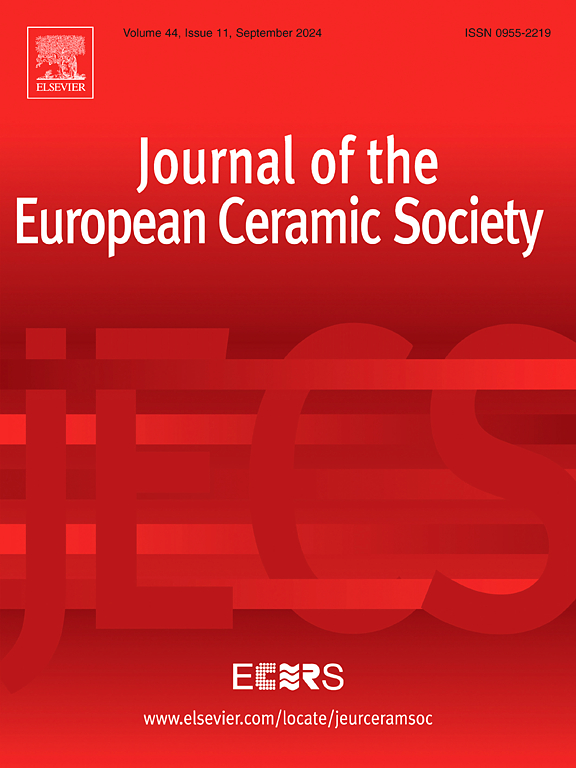Tin-rich nano-fluorite evolution in bixbyite indium tin oxide ceramics
IF 6.2
2区 材料科学
Q1 MATERIALS SCIENCE, CERAMICS
Journal of The European Ceramic Society
Pub Date : 2025-05-16
DOI:10.1016/j.jeurceramsoc.2025.117538
引用次数: 0
Abstract
This study presents an unprecedented experimental observation of fluorite-structured nano-precipitates (NPs) within bulk ITO grains. These NPs, containing higher Sn concentrations than the ITO matrix, form coherent interfaces with the bixbyite (ITO matrix) structure, representing nanoscale compositional heterogeneities that have remained undetected. The NPs form through charge compensation, as local Sn enrichment drives oxygen interstitials to fill intrinsic oxygen vacancies of the bixbyite structure, and their features can be tuned via reduction treatment or heat treatment temperature. EXAFS analysis of samples with high NP density revealed elevated coordination numbers for Sn ions, supporting the presence of oxygen interstitials. Formation of NPs occurs during post-sintering cooling when Sn ions, initially dissolved at high temperatures, are expelled due to decreased solubility. While 2 defect clusters in ITO have been previously discussed only through theoretical predictions, this study provides the experimental observation of such clusters in the form of NPs.
bixbyite氧化铟锡陶瓷中富锡纳米萤石的演化
这项研究提出了一个前所未有的实验观察萤石结构的纳米沉淀(NPs)在散装ITO颗粒。这些NPs含有比ITO基体更高的Sn浓度,与bixbyite (ITO基体)结构形成相干界面,代表了未被检测到的纳米级组成非均质性。NPs是通过电荷补偿形成的,因为局部的锡富集驱动氧间隙填补了bixbyite结构的固有氧空位,它们的特征可以通过还原处理或热处理温度来调节。高NP密度样品的EXAFS分析显示,Sn离子的配位数升高,支持氧间隙的存在。NPs的形成发生在烧结后的冷却过程中,最初在高温下溶解的Sn离子由于溶解度降低而被排出。虽然以前只通过理论预测讨论过ITO中的2SnIn•Oi″¹缺陷簇,但本研究提供了以NPs形式的这种簇的实验观察。
本文章由计算机程序翻译,如有差异,请以英文原文为准。
求助全文
约1分钟内获得全文
求助全文
来源期刊

Journal of The European Ceramic Society
工程技术-材料科学:硅酸盐
CiteScore
10.70
自引率
12.30%
发文量
863
审稿时长
35 days
期刊介绍:
The Journal of the European Ceramic Society publishes the results of original research and reviews relating to ceramic materials. Papers of either an experimental or theoretical character will be welcomed on a fully international basis. The emphasis is on novel generic science concerning the relationships between processing, microstructure and properties of polycrystalline ceramics consolidated at high temperature. Papers may relate to any of the conventional categories of ceramic: structural, functional, traditional or composite. The central objective is to sustain a high standard of research quality by means of appropriate reviewing procedures.
 求助内容:
求助内容: 应助结果提醒方式:
应助结果提醒方式:


